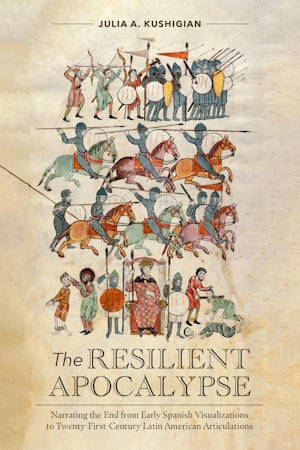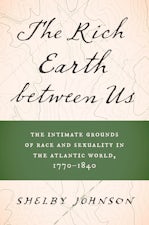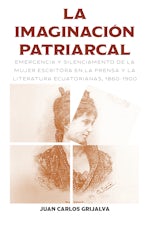The Resilient Apocalypse
Narrating the End from Early Spanish Visualizations to Twenty-First Century Latin American Articulations
By Julia A. Kushigian

258 pp., 6 x 9, 6 figs, bibl., index
-
Paperback ISBN: 978-1-4696-8188-7
Published: May 2024 -
E-book EPUB ISBN: 978-1-4696-8189-4
Published: May 2024 -
E-book PDF ISBN: 978-1-4696-8190-0
Published: May 2024
Paperback Available May 2024, but pre-order your copy today!
Buy this Book
Distributed for the University of North Carolina at Chapel Hill Department of Romance Studies
Portraits of good battling evil in the geography of hell come in many forms in the Hispanic World. Apocalyptic nightmares, frightful images of chaos and death are inclusive and interrelated, yet simultaneously project an exceptional quality (“never seen or experienced before,” “the mother of all battles,” “I am the only one who can fix it”). This investigation explores how narrative logic may challenge unified notions of finalities when images remain unfulfilled in a proscribed End. By redeploying transglobal character and narrative potential, the Apocalypse suggests bewildering complexities as it trains its lens on New Beginnings. Here analysis explores resilient formulas for combating the End through resistance in Latin America, Spain and Latin@ communities in the US. Whether revealed through gilded illustrations, messianic chronicles, poetry, Baroque letters, racially-motivated novels, sexuality and spirituality in film or intimidating immigrant photos, apocalyptic examples explode notions of final moments. The Resilient Apocalypse ironically performs as both an internal defense (a vehicle for mourning) and a counter-discourse to power (a mechanism for resistance). This study argues for a strategy that listens to and keeps the enemy “in sight and in mind,” a method for grappling with and engaging difference by decolonizing the politics of the End. It reformulates an incomplete, mythical, and uncanny narrative into a poetics of resistance with communal solutions and obligations. When the Apocalypse is unremittingly sought after to impose social justice, salvation and reason, it paradoxically introduces future hope against itself. In the works of Beato de Liébana, Sor Juana Inés de la Cruz, Cirilo Villaverde, Cristina García, Martín Kohan, Jennifer Maytorena Taylor, Santiago Roncagliolo, Alfonso Cuarón, etc., rival traditions internalize competing apocalyptic worldviews and arrive at sustainable plans of action for negotiating the afterward. By bracketing the finality of the End and proposing a tension between conflict archaeology and the transcendence of opposition through renovation, salvation or hope, this study reveals how plural, competing viewpoints of the End go a long way to legitimizing each other. Ultimately, The Resilient Apocalypse traces a compelling narrative theory of unfulfilled promise that forever changes the way we engage the other and value the self during intervals of fear.



